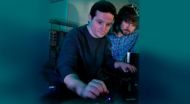(Press-News.org) This news release is available in German.
The hunt is on – for new materials to be used in the next generation of batteries that may one day replace current lithium ion batteries. Today, the latter are commonplace and provide a reliable power source for smartphones, laptops and many other portable electrical devices.
On the one hand, however, electric mobility and stationary electricity storage demand a greater number of more powerful batteries; and the high demand for lithium may eventually lead to a shortage of the raw material. This is why conceptually identical technology based on sodium-ions will receive increasing attention in coming years. Contrary to lithium batteries, researched for more than 20 years, much less is known about materials that can efficiently store sodium ions.
Antimony electrodes?
A team of researchers from ETH Zurich and Empa headed by Maksym Kovalenko may have come a step closer to identifying alternative battery materials: they have become the first to synthesise uniform antimony nanocrystals, the special properties of which make them prime candidates for an anode material for both lithium-ion and sodium-ion batteries. The results of the scientists' study have just been published in Nano Letters.
For a long time, antimony has been regarded as a promising anode material for high-performance lithium-ion batteries as this metalloid exhibits a high charging capacity, by a factor of two higher than that of commonly used graphite. Initial studies revealed that antimony could be suitable for rechargeable lithium and sodium ion batteries because it is able to store both kinds of ions. Sodium is regarded as a possible low-cost alternative to lithium as it is much more naturally abundant and its reserves are more evenly distributed on Earth.
For antimony to achieve its high storage capability, however, it needs to be produced in a special form. The researchers managed to chemically synthesize uniform – so-called "monodisperse" – antimony nanocrystals that were between ten and twenty nanometres in size.
The full lithiation or sodiation of antimony leads to large volumetric changes. By using nanocrystals, these modulations of the volume can be reversible and fast, and do not lead to the immediate fracture of the material. An additional important advantage of nanocrystals (or nanoparticles) is that they can be intermixed with a conductive carbon filler in order to prevent the aggregation of the nanoparticles.
Ideal candidate for anode material
Electrochemical tests showed Kovalenko and his team that electrodes made of these antimony nanocrystals perform equally well in sodium and in lithium ion batteries. This makes antimony particularly promising for sodium batteries because the best lithium-storing anode materials (Graphite and Silicon) do not operate with sodium.
Highly monodisperse nanocrystals, with the size deviation of ten percent or less, allow identifying the optimal size-performance relationship. Nanocrystals of ten nanometers or smaller suffer from oxidation because of the excessive surface area. On the other hand, antimony crystals with a diameter of more than 100 nanometres aren't sufficiently stable due to aforementioned massive volume expansion and contraction during the operation of a battery. The researchers achieved the best results with 20 nanometer large particles.
Performance not so size dependent
Another important outcome of this study, enabled by these ultra-uniform particles, is that the researchers identified a size-range of around 20 to 100 nanometres within which this material shows excellent, size-independent performance, both in terms of energy density and rate-capability.
These features even allow using polydisperse antimony particles to obtain the same performance as with very monodisperse particles, as long as their sizes remain within this size-range of 20 to 100 nanometres.
"This greatly simplifies the task of finding an economically viable synthesis method", Kovalenko says. "Development of such cost-effective synthesis is the next step for us, together with our industrial partner." Experiments of his group on monodisperse nanoparticles of other materials show much steeper size-performance relationships such as quick performance decay with increasing the particle size, placing antimony into a unique position among the materials which alloy with lithium and sodium.
More expensive alternative
Does this mean that an alternative to today's lithium-ion batteries is within our grasp? Kovalenko shakes his head. Although the method is relatively straightforward, the production of a sufficient number of high-quality uniform antimony nanocrystals is still too expensive.
"All in all, batteries with sodium-ions and antimony nanocrystals as anodes will only constitute a highly promising alternative to today's lithium-ion batteries if the costs of producing the batteries will be comparable," says Kovalenko.
It will be another decade or so before a sodium-ion battery with antimony electrodes could hit the market, the ETH-Zurich professor estimates. The research on the topic is still only in its infancy. "However, other research groups will soon join the efforts," the chemist is convinced.
INFORMATION: END
Antimony nanocrystals for batteries
2014-03-18
ELSE PRESS RELEASES FROM THIS DATE:
Study of complete RNA collection of fruit fly uncovers unprecedented complexity
2014-03-18
BLOOMINGTON, Ind. -- Scientists from Indiana University are part of a consortium that has described the transcriptome of the fruit fly Drosophila melanogaster in unprecedented detail, identifying thousands of new genes, transcripts and proteins.
In the new work, published Sunday in the journal Nature, scientists studied the transcriptome -- the complete collection of RNAs produced by a genome -- at different stages of development, in diverse tissues, in cells growing in culture, and in flies stressed by environmental contaminants. To do so, they used contemporary sequencing ...
Ultrasound can identify pregnant women at risk for respiratory failure, study says
2014-03-18
An ultrasound of the lungs could help doctors quickly determine if a pregnant woman with preeclampsia is at risk for respiratory failure, suggests preliminary research published in the April issue of Anesthesiology.
About 60,000 women worldwide die as a result of preeclampsia, which causes severely high blood pressure. Potential complications include stroke, bleeding and excess fluid in the lungs – called pulmonary edema – which can lead to respiratory failure. The study suggests a lung ultrasound can help doctors easily learn whether a woman with preeclampsia is suffering ...
Cardiac arrest in pregnant women more common than you'd think
2014-03-18
Although cardiac arrest during childbirth is rare, it may be two times more common than previously reported in the literature, suggests the first large U.S. study on the potentially deadly condition published in the April issue of Anesthesiology. The study, based on data for more than 56 million births, also found that cardiopulmonary resuscitation (CPR) was often successful, and that the survival rate improved between 1998 and 2011.
Maternal cardiac arrest means that the mother's heart stops beating, either before or after childbirth. More than one in 12,000 American ...
Why international sanctions do not always work
2014-03-18
Germany, Austria and Cuba have at least one thing in common: they have all experienced what it means to be 'left out in the cold' and be considered 'bad company' by Western powers. However, just as Iran and South Africa, these three countries have handled this form of stigmatization very differently. According to new research, the reason for this is that diplomatic pressure and sanctions by the international community (the 'shaming method' ) fail to have the intended effect because isolation and shaming may boost national pride and sense of cohesion and thus support the ...
Many low-income women don't want to leave hospital after false-labor diagnosis
2014-03-18
More than 40 percent of pregnant low-income women discharged from the hospital after a diagnosis of false or early labor did not want to be sent home, with the most common reasons being that they were in too much pain or lived too far away, according to a study by Baylor University's Louise Herrington School of Nursing (LHSON) and Parkland Health & Hospital System.
Many of the women dissatisfied with being sent home stated that receiving specific written instructions about when to return to the hospital may have made them happier about going home. However, there was evidence ...
Indochina agricultural fires still ongoing
2014-03-18
Agricultural fires continue to burn in the Indochina region as evidenced by this Aqua image taken on March 18, 2014. This natural-color image was taken by the Moderate Resolution Imaging Spectroradiometer, MODIS, aboard the Aqua satellite. More fires have been set in both Burma and Laos since the last image taken by MODIS on March 07. Actively burning areas, detected by MODIS's thermal bands, are outlined in red. Fire is used in cropland areas for pest and weed control and to prepare fields for planting. Crop residue burning helps farmers as it is a cheap and effective ...
Scientists open a new window into quantum physics with superconductivity in LEDs
2014-03-18
A team of University of Toronto physicists led by Alex Hayat has proposed a novel and efficient way to leverage the strange quantum physics phenomenon known as entanglement. The approach would involve combining light-emitting diodes (LEDs) with a superconductor to generate entangled photons and could open up a rich spectrum of new physics as well as devices for quantum technologies, including quantum computers and quantum communication.
Entanglement occurs when particles become correlated in pairs to predictably interact with each other regardless of how far apart they ...
NASA sees some strength left in remnants of Tropical Cyclone Gillian
2014-03-18
NASA's TRMM satellite passed over the remnants of Tropical Cyclone Gillian and spotted some towering thunderstorms and areas of heavy rainfall, indicating there's still power in the former tropical storm.
Over the past few days former tropical cyclone Gillian's remnants moved from the Gulf of Carpentaria into the Timor Sea. The Tropical Rainfall Measuring Mission satellite known as TRMM found a few strong convective thunderstorms when it passed above these remnants on March 18, 2014 at 0431 UTC. TRMM's Precipitation Radar (PR) instrument measured rain falling at a rate ...
Incentives needed to improve grain markets in India
2014-03-18
URBANA, Ill. – Even after the agricultural reforms of 2002-03, for wheat, rice, and pearl millet farmers in India, grain markets are still pretty sticky. Two University of Illinois economists analyzed infrastructure of interstate trade for food-grain crops in three Indian states and found that grain farmers are unable to cash in on India's market reforms and take advantage of a price difference between two or more markets.
"We wanted to see if there was more integration in the markets since the 2002 reforms," said Kathy Baylis. "We were surprised at how little integration ...
MU study uses video-game device with goal of preventing patient falls
2014-03-18
Technology used in video games is making its way to hospital rooms, where researchers at the University of Missouri hope to learn new ways to prevent falls among hospital patients.
Between 700,000 and 1 million people each year fall in U.S. hospitals, according to the Agency for Healthcare Research and Quality. Hospitals nationwide are looking for ways to reduce that number.
"Since 2008, we've investigated ways to detect and prevent falls by older adults living in independent senior apartments," said Marilyn Rantz, PhD, RN, a leader of the MU research team and a professor ...







